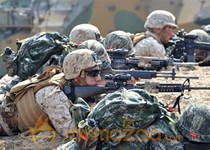South Korean Marines fired artillery shells across a disputed sea border Monday after North Korean shells from a live fire drill conducted by Pyongyang fell into the water south of the frontier, Seoul officials told the Associated Press.
No shells from either side were fired at any land or military installations, an official with South Korea's Joint Chiefs of Staff said. He provided no other details and spoke on condition of anonymity because of office rules. There were no immediately reports of any injuries. However, residents of a South Korean island near the border said that they had been moved to emergency shelters during the firing.
Kang Myeong-sung, speaking from a shelter on Yeonpyeong island, which is in sight of North Korean territory, said that anxious islanders were huddled together in shelters. Kang said he didn't see any fighter jets, but he could hear the boom of artillery fire. In 2010, North Korean artillery killed four South Koreans on Yeonpyeong.
The exchange of fire followed Pyongyang's earlier, unusual announcement that it would conduct the drills, a move seen as an expression of Pyongyang's frustration at making little progress in its recent push to win outside aid.
The North in recent weeks has increased threatening rhetoric and conducted a series of rocket and ballistic missile launches that are considered acts of protest against annual ongoing springtime military exercises by Seoul and Washington. The North calls the South Korea-U.S. drills a rehearsal for invasion; the allies say they're routine and defensive.
Pyongyang threatened Sunday to conduct a fourth nuclear test at some point, though Seoul says there are no signs of an imminent detonation.
After the North's earlier announcement Monday that it would conduct firing drills in seven areas north of the sea boundary, South Korea responded that it would strongly react if provoked.
Pyongyang routinely test-fires artillery and missiles into the ocean, but it's rare for the country to disclose such training plans in advance. Wee Yong-sub, a deputy spokesman at the South Korean Defense Ministry, said the North Korean message was a "hostile" attempt to heighten tension on the Korean Peninsula.
The poorly marked western sea boundary has been the scene of several bloody naval skirmishes between the Koreas in recent years. In 2010, North Korea launched artillery strikes on a front-line South Korean island near the boundary, killing four. Pyongyang said it was responding to earlier South Korea's artillery drills that day.
Last spring, tension spiked after a near-daily barrage of North Korean threats, including warnings of nuclear strikes against Seoul and Washington, following international criticism of Pyongyang's third nuclear test in February of last year. The North has since gradually dialed down its threats and sought improved ties with South Korea in what foreign analysts say is an attempt to lure international investment and aid. There has been no major breakthrough in the North's reported push to win outside aid, however, with Washington and Seoul calling on the North to first take disarmament steps to prove its sincerity about improving ties, analysts say.
The North Korean live-fire drills and the country's hints at a nuclear test are meant to express anger and frustration over what the North sees as little improvement in progress in its ties with South Korea and the U.S., said Lim Eul Chul, a North Korea expert at South Korea's Kyungnam University. Lim said the North might conduct a fourth nuclear test and launch other provocations to try to wrest the outside concessions it wants.
The Korean Peninsula remains in a technical state of war because the 1950-53 Korean War ended with an armistice, not a peace treaty. About 28,500 American troops are deployed in South Korea to deter potential aggression from North Korea.







